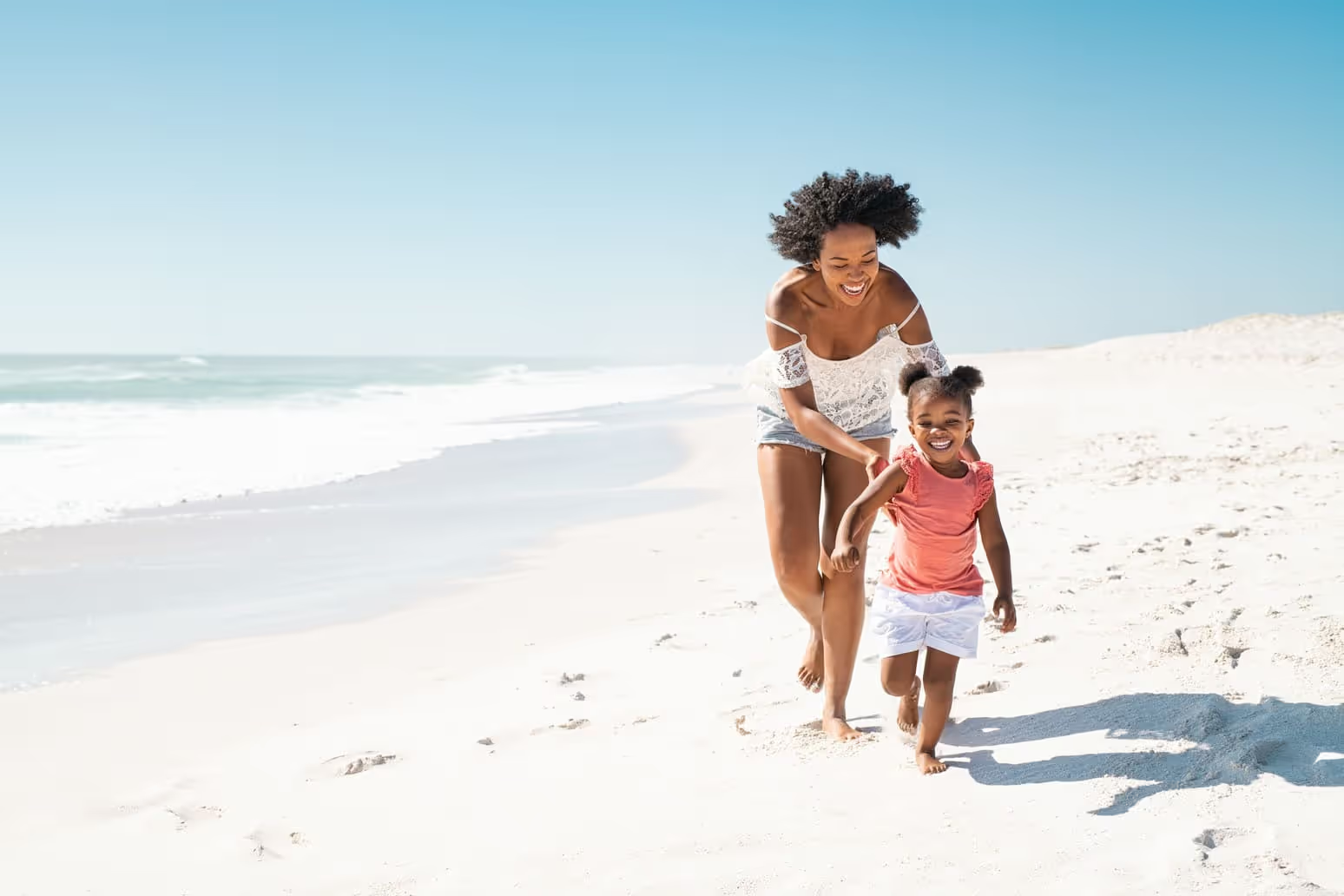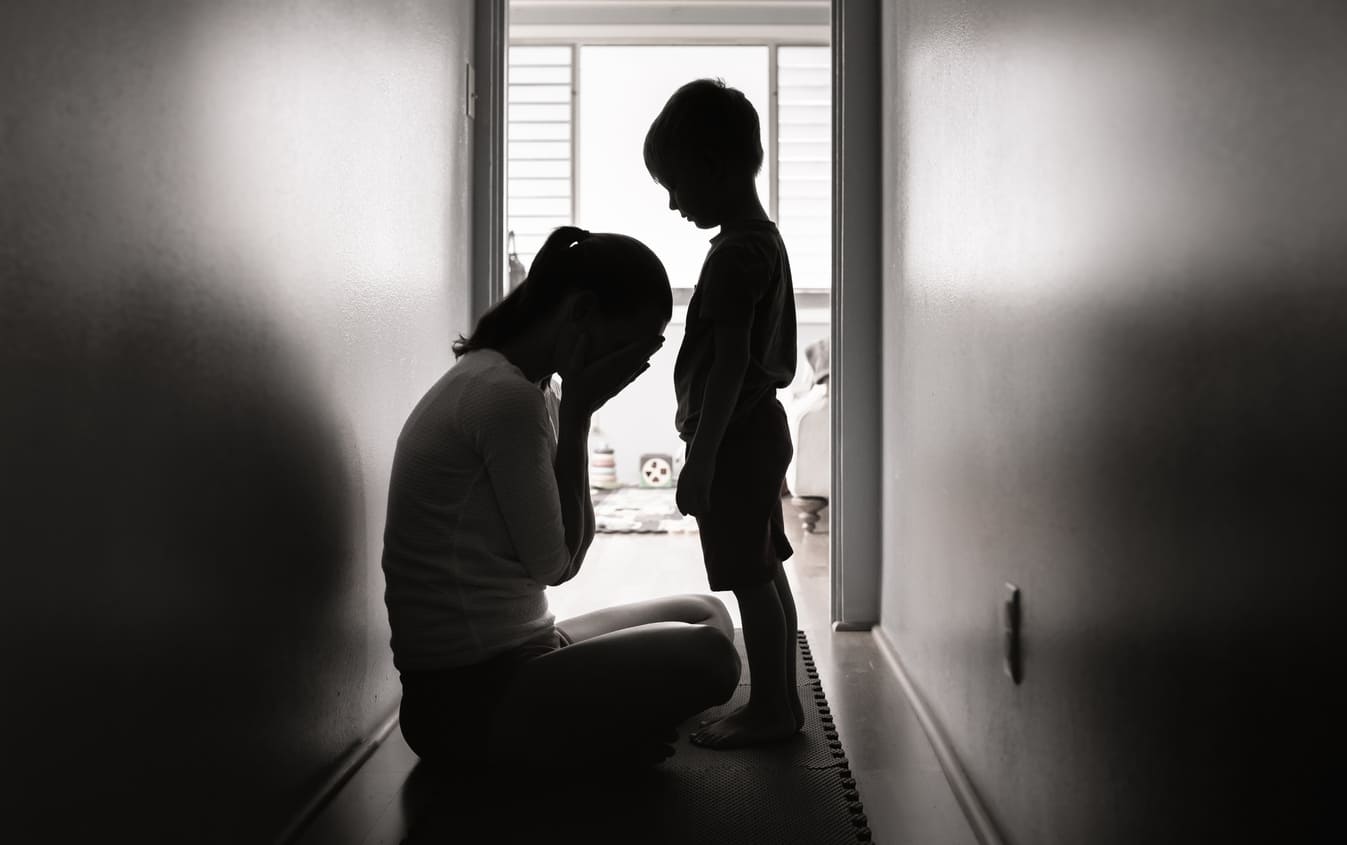It's truly amazing to think that when a baby is born, they possess a vast number of the neurons (nerve cells) they will ever have. The subsequent years, especially the first three, are critical for these cells to form trillions of connections that shape the brain's architecture. From birth, babies are attuned to human voices, particularly their mother's, and their auditory system rapidly develops, laying the groundwork for recognizing other familiar sounds and voices in the initial weeks. From the very beginning, a baby's brain is actively developing the foundations for learning and memory, a process that accelerates rapidly during the first few years. This is the start of a lifelong journey of discovery!

Understanding these milestones is crucial in supporting a child's development. This knowledge empowers both parents and nannies, acting as a wonderful guide to craft developmentally appropriate activities and experiences that spark curiosity and build new skills. When families and nannies are on the same page, observing and delighting in these emerging abilities, it creates a dynamic partnership. Nannies, with their daily interactions, often become keen observers, noticing those subtle shifts and new accomplishments that signal growth. Sharing these moments—"Leo spent so much time trying to grasp that toy today, and he finally did it!"—can be a joyful exchange, strengthening the connection between home and care.
This shared awareness also helps in sensitively identifying potential delays or areas where a child might benefit from a little extra support. It’s not about comparison, but about understanding each child's individual timeline and ensuring they have everything they need. Open, respectful conversations between nannies and families about these observations are invaluable. For instance, a nanny might share, "I've noticed Maya isn't yet responding to her name as consistently as the guidelines suggest for her age; is this something you’ve noticed during your time with her? It may be worth bringing it up with her pediatrician if it continues."
This collaborative approach ensures that if there are any concerns, families feel supported in seeking additional support from professionals when needed. By recognizing and celebrating these developmental achievements together, and by approaching any questions with teamwork and care, we can truly provide the best possible support for children as they joyfully grow and learn on their own amazing path.
What Are Developmental Milestones?
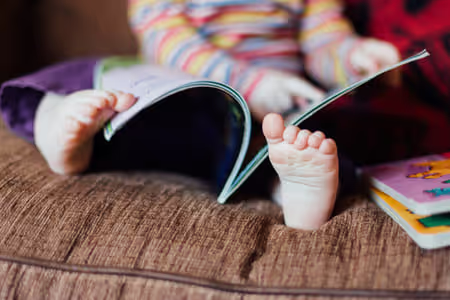
Watching a little one grow is like witnessing a daily dose of magic! One moment they're tiny and dependent, and the next, they're embarking on incredible adventures of movement and discovery. You'll see them master their bodies, perhaps going from wobbly efforts to confident crawling (often between 7-9 months), then thrillingly pulling to a stand and maybe even taking those first supported steps around 9-12 months.
It's just as exciting to hear their communication blossom. Those initial words can lead to a rapid expansion of vocabulary around 15 months, opening up a whole new world of charming conversations. And who doesn't marvel as their coordination sharpens? Think of those first adorable attempts at clapping (a skill often shining around 15 months), or much later, the focused effort it takes to turn the pages of a book one by one (usually closer to 30 months). Each of these achievements is a testament to their growing independence.
These captivating steps forward are what we often refer to as developmental milestones.
Understanding Developmental Milestones
Developmental milestones are basically skills or behaviors that most children can do by a certain age. They give us a great framework for understanding how a child is growing and developing. And these milestones happen across several key areas:
- Physical Development: This includes both those big movements, like walking and crawling (that's gross motor), and the smaller, more precise movements, like grabbing and holding objects (that's fine motor).
- Cognitive Development: This is all about thinking, learning, and how kids solve problems.
- Social and Emotional Development: This is how children interact with others, understand their feelings, and start to know themselves.
- Communication and Language Development: This includes both understanding and using language, whether through spoken words or nonverbal cues.
It's important to remember that every child progresses at their own pace.
These milestones just give us a general idea of what to expect as a child grows. It's also crucial to recognize that variations in development can arise from neurodevelopmental differences. Traits such as heightened sensory sensitivity, unique learning styles, and variations in social interaction are valid expressions of human diversity. However, by understanding typical developmental patterns, we can also identify areas where a child's development diverges significantly, potentially indicating a neurodevelopmental disorder or cognitive delay. Early identification of these differences allows for the provision of timely and tailored interventions, ensuring that all children receive the support and resources they need to thrive and reach their full potential. To further support this, it's helpful to know that The American Academy of Pediatrics suggests that children be screened for general development using standardized, validated tools at 9, 18, and 30 months, and for autism at 18 and 24 months or whenever a concern arises.
Note About Sources: Developmental milestones can be a hot topic, with lots of opinions floating around, that’s why we’ve included a list of our sources at the end of this post so you can see where our information comes from. Just remember that even a well sourced and documented blog post is not a substitute for professional medical advice. If you have any concerns about your child's development, please consult your pediatrician.
Developmental Milestones from 0 to 3 Years
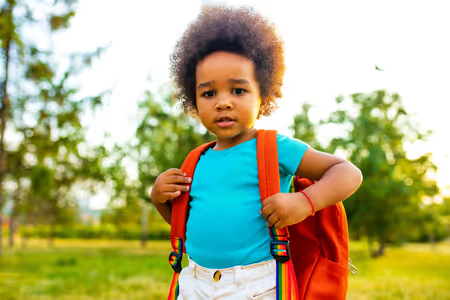
While the first three years of life typically follow a fairly predictable developmental timeline, it's important to remember that this period lays the foundation for future growth. Most children acquire skills and reach milestones within a relatively similar timeframe during these early years. However, it's also a time when individual differences may begin to emerge. These differences can be influenced by a variety of factors, including genetics, environment, and individual temperament.
A keen awareness of typical development during this period allows household professionals and families to support the healthy integration of a child's sensory systems, promoting optimal development. Staying informed about these milestones also enables the early identification of potential divergences, which may indicate an underlying medical or developmental need. Recognizing these differences early on allows for prompt consultation with a pediatrician or specialist, ensuring that children receive the necessary support and interventions to address any challenges and maximize their developmental trajectory.
So, let's explore some key milestones during the first three years, giving you a general overview of what you might see.
0 to 6 Months
Ah, the newborn days! A whirlwind of tiny hands, sleepy snuggles, and figuring out just how many diapers one human can possibly go through. But amidst the exhaustion, you'll witness a period of truly remarkable change as your baby's senses sharpen and their little bodies begin to move in increasingly coordinated ways. Here's a breakdown of what you might see month by month:

Newborn (0-1 month)
- Physical Development:
- Strong reflexes like sucking and grasping are present from birth. (Those tiny fingers can hold on surprisingly tight!)
- Moves head from side to side when placed on stomach (a precursor to holding head up), demonstrating early neck control and the first steps towards exploring their surroundings.
- Cognitive Development:
- Focus on faces, showing a preference for human interaction and a keen interest in the people who will be their world.
- Responds to loud sounds, indicating auditory perception and a startle reflex that lets you know they're definitely paying attention.
- Social and Emotional Development:
- Seeks comfort from those around them through crying and physical closeness.
- May show fleeting reflex smiles. True social smiles, a direct response to your interaction, typically emerge closer to two months and are a delightful sign of early bonding. (Get ready for those heart-melting grins!)
- Communication and Language Development:
- Cries to express needs, which will soon become more differentiated. (You'll become a pro at deciphering these!)
- Makes sounds other than crying, such as grunts and sighs, those first little noises that aren't distress.
2 Months
- Physical Development:
- Can lift their heads briefly during tummy time; tummy time helps strengthen neck and shoulder muscles for future rolling and sitting.
- Moves arms and legs with increasing purposefulness; those little kicks and waves are becoming more coordinated and less random.
- Social and Emotional Development:
- Begins to smile socially in response to interaction, not just reflexively!
- Seems happy to see you, showing a preference for familiar faces and voices, you're not just a blur anymore!
- Communication and Language Development:
- Begins to coo, producing vowel-like sounds in early attempts at communication, like "ooo" and "ahh."
- Reacts to loud sounds, indicating auditory development. May sometimes turn towards a very interesting or sustained sound, though consistent head turning to sound sources develops more fully in the coming months.
3 Months
- Physical Development:
- Brings hands to mouth (a skill developing around 2-3 months) for exploration and comfort: Vogue is a classic move for this age.
- Follows moving objects with eyes, demonstrating improved visual tracking skills; their vision is getting sharper by the day.
- Cognitive Development:
- Starts to show interest in their surroundings, visually exploring people and objects with increasing attention.
- Watches your face intently, observing expressions and becoming more responsive to your emotional tone and facial cues. Are they trying to figure out what you're feeling?
- Social and Emotional Development:
- Becomes more communicative and expressive with face and body, using gestures and expressions to engage.
- Enjoys playing with other people, showing a growing desire for social interaction and playtime.
4 Months
- Physical Development:
- May begin to roll from their tummy to their back, a new way to explore their environment and a sign of increasing coordination.
- Holds head steady without support (improving significantly by 4 months), indicating improved neck and upper body strength, which means more upright time!
- Cognitive Development:
- Shows sustained attention to toys, looking at them for several seconds or longer, an advance from earlier brief glances.
- Shows increasing recognition of familiar people and objects (noted at 6 months by AAP, develops gradually), even from a short distance.
- Social and Emotional Development:
- Chuckles (a sound often preceding a full laugh) when you try to make them laugh – a delightful and rewarding sound that encourages interaction!
- Imitates some movements and facial expressions, engaging in early social learning and interaction.
- Communication and Language Development:
- Engages in more varied vocal play, expanding on cooing sounds and experimenting with raspberries, squeals, and other noises. True babbling with consonant-vowel combinations typically emerges in the next couple of months.
- Smiles at the sound of your voice, showing a strong positive association with people close to them. (You're their happy place.)
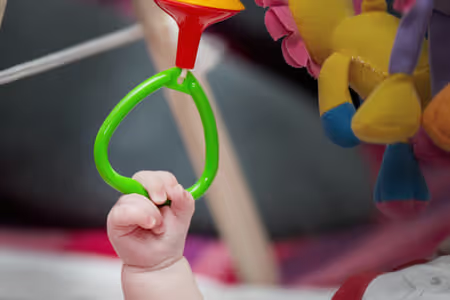
5 Months
- Physical Development:
- May roll over from back to front, showing improved coordination and mobility in all directions.
- Reaches for and grasps objects with more intention and accuracy (skill refining around this age), showing developing hand-eye coordination.
- Cognitive Development:
- Explores objects with hands and mouth, using tactile and oral exploration to learn about textures and shapes. (Still exploring everything with their mouths...)
- Watches objects as they move, demonstrating smooth visual tracking and an understanding of movement.
- Social and Emotional Development:
- Shows clearer recognition of familiar people versus unfamiliar ones. True stranger anxiety often becomes more apparent in the coming months (more prominent at 9 months per AAP).
- Responds to affection with increasing enthusiasm, displaying joy and excitement during interactions.
- Communication and Language Development:
- Uses voice to express joy and displeasure (differentiation increases with age), conveying a wider range of emotions, from happy squeals to fussy cries.
- Vocalizations become more complex, with more experimentation with sounds like growls, squeals, and early consonant-like and vowel-like sounds (marginal babbling). Reduplicated babbling (e.g., 'bababa') typically begins closer to 6 months or later (well underway by 9mo per AAP). Are those actual words?! Probably not. But you can pretend!
6 Months
- Physical Development:
- Many babies can sit with some support (precursor to independent sitting at 9mo per AAP), allowing them to engage with the world from a new perspective and freeing up their hands.
- Pushes up with straight arms when on tummy, demonstrating increasing strength for crawling and other movements.
- Cognitive Development:
- Begins to understand cause and effect, grasping how their actions impact the environment, like banging a toy to make noise.
- Looks around at surroundings with increasing curiosity, taking in the sights and sounds of their world.
- Social and Emotional Development:
- Clearly recognizes familiar people. Some infants may begin to show wariness around strangers, though more pronounced stranger anxiety often develops in the following months (characteristic ~8-9 months).
- Enjoys looking at themselves in a mirror, a step towards self-awareness and recognizing their own image. (Who's that adorable human?)
- Communication and Language Development:
- Responds to own name (emerges ~5-9 months, established by 9mo per AAP), demonstrating understanding and recognition when you call them.
7 to 9 Months

So, you've survived the first six months! Now, get ready for even more action as your baby becomes increasingly mobile and expressive. This period is often marked by a surge in curiosity and a growing desire to explore the world, often on all fours (or on their bottoms, or however they can manage it!). Communication is also becoming more sophisticated, with babbling evolving into more recognizable sounds and the beginnings of true language.
- Physical Development:
- Sits without support: Free hands! Don't worry, they’ll go straight in their mouth.
- Begins to crawl: Watch out, world!
- Cognitive Development:
- Looks for hidden objects: The magic of "object permanence". It’s Peek-a-boo season!
- Starts to imitate gestures: Waving bye-bye is the new cool thing.
- Social and Emotional Development:
- Shows increased stranger anxiety: They're getting pickier about who they hang out with. But let’s be honest, if you’re not getting enough sleep, you might be too.
- Plays peek-a-boo: Still a classic for a reason!
- Communication and Language Development:
- Engages in prominent reduplicated babbling (e.g., 'mamama,' 'dadada'). While these sounds are not yet true words with consistent meaning, they are important precursors. First words with specific meaning typically emerge closer to 12 months. Forreal this time!
- Increasingly responds to their own name, showing they know who you're talking to and turning their attention your way.
9 to 12 Months
Congratulations, you've almost made it to the one-year mark! This stage is all about refining those newly acquired skills and gearing up for even bigger milestones. Babies at this age are becoming more interactive, showing a wider range of emotions, and their language comprehension is really taking off. Get ready for a whirlwind of activity as they pull themselves up, cruise around furniture, and maybe even take those first wobbly steps.
- Physical Development:
- Pulls self up to stand, using whatever they can find for leverage (coffee tables, your legs—nothing is safe!).
- May take first steps with support; the beginning of a beautiful, tiring journey.
- Cognitive Development:
- Explores objects in different ways (banging, throwing, etc.); everything is a science experiment.
- Starts to learn how to use objects correctly, such as attempting to drink from a cup with assistance; they're figuring out how things work.
- Social and Emotional Development:
- Becomes more independent, often asserting their will with a determined "Me do it!"... even if it takes ten minutes.
- Shows a range of emotions, from pure joy to epic meltdowns, and everything in between.
- Communication and Language Development:
- Says simple words, e.g., "mama," "dada"; the first real words... cue the waterworks.
- Begins to understand very simple, routine instructions, especially when accompanied by gestures (e.g., 'wave bye-bye' or 'give me the ball'). We’ve all seen it “can you clap for mommy?” and the look of sheer concentration on their face.
12 to 18 Months
Welcome to toddlerhood! This is where things get really interesting. Walking is becoming more

and more confident, language is exploding, and your little one is developing a serious sense of self. Prepare for a fascinating mix of independence, curiosity, and the occasional tantrum as they navigate this exciting new phase.
- Physical Development:
- Walks alone: They're off and running... literally.
- Starts to use hands to feed themselves: Mealtime gets a lot more independent…and messier.
- Cognitive Development:
- Begins to use objects symbolically: e.g., pretending to drink from an empty cup.
- Shows increasing curiosity: They might not be asking “why?” yet, but you can be sure they’re trying to figure it out, even if it seems like they’re just trying stress you out by putting themselves in dangerous situations.
- Social and Emotional Development:
- Imitates others: You're their role model, so watch what you say and do!
- Shows affection: Get ready for lots of hugs and sloppy kisses (this is honestly the best part).
- Communication and Language Development:
- Says several single words: Their vocabulary is expanding rapidly, sometimes you can understand it, sometimes you try your best and guess.
- Points to objects: "What's dat? What's dat? What's dat?".
18 to 24 Months
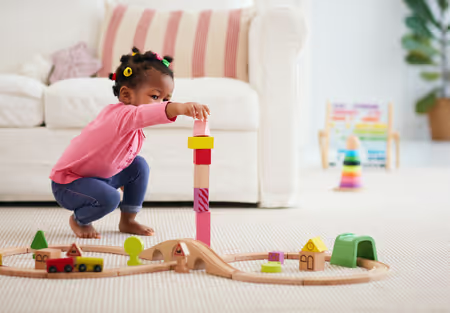
Your little one is now a full-fledged toddler, with all the personality and determination that comes with it. Language skills are becoming more complex, imaginative play is in full swing, and they're starting to test boundaries like a tiny explorer charting new territory.
- Physical Development:
- Walks up and down stairs with support: They're mastering those stairs! Again, and again, and again (IYKYK).
- Begins to run: Like, really fast. Always make sure at least one adult in your party is wearing shoes you can run in when out and about when traveling with children this age.
- Cognitive Development:
- Begins to engage in pretend play: The tea parties and superhero adventures begin! Be prepared to “eat” lots of questionable creations from the pretend kitchen or playdough table.
- Begins to sort objects by shape and color: Learning about the world, one shape at a time.
- Social and Emotional Development:
- Plays alongside other children: Making friends... sort of. It’s kinda like when you and your best friend sit on the couch and both read a book, but separately. We call this parallel play.
- Shows a growing sense of self: "Me do it!"... even when “it” is using a large kitchen knife or carrying something twice their weight.
- Communication and Language Development:
- Uses two-word sentences: "More juice," "Go park,”. Although “No” tends to be a favorite still.
- Follows simple one-step instructions (e.g., 'Get your shoes'). The ability to follow more complex, two-step instructions typically develops closer to 30 months. Sometimes. When they feel like it.
2 to 3 Years
Buckle up, because the "threenager" years are approaching! This period is marked by a surge in language development, increasing social interaction, and a growing desire to be independent. Children at this age are becoming more physically coordinated, more verbal, and more opinionated.

- Physical Development:
- Runs easily: You should be pretty in shape by now, if not, consider marathon training.
- Jumps with both feet: Up and down, up and down...
- Cognitive Development:
- Begins to understand time concepts: "Yesterday," "tomorrow"... kind of. If you tell them about your family vacation happening in 3 months, that is the same as “tomorrow”, don't say we didn’t warn you.
- Engages in more complex pretend play: The stories get longer and more elaborate. If you’re lucky, you’ll get to share your home with a part time human, part time kitty cat for long stretches of time during this stage.
- Social and Emotional Development:
- Shows a wider range of emotions: Prepare for the full spectrum. For them and for yourself.
- Social play develops: Starts to play with other children. Cooperation is... emerging.
- Communication and Language Development:
- Uses three-word sentences: If you’re lucky, maybe even four, e.g. "I want that … now!".
- Has a rapidly expanding vocabulary: You'll be amazed by what they pick up, so time to clean up your vocabulary and consider getting headphones for your favorite murder mystery podcast, if you haven't already.
The Wild and Wonderful Journey
From those first reflexive movements to the complex language and social interactions of a three-year-old, the journey of child development is a rollercoaster of incredible change. It's a time filled with moments of pure joy, hilarious antics, and the occasional meltdown that tests your patience. But through it all, understanding these developmental milestones allows us to provide the best possible care, support their unique needs, and celebrate every step of the way as they grow into the amazing humans they're destined to become.
Sources:
- Mayo Clinic, "Infant development: Birth to 3 months," https://www.mayoclinic.org/healthy-lifestyle/infant-and-toddler-health/in-depth/infant-development/art-20048012
- AAP, "2 Month - 5 Early Relational Health Developmental Milestone Timeline," https://www.aap.org/en/patient-care/early-childhood/milestone-timeline/
- CDC, "Important Milestones: Your Baby By Two Months," https://www.cdc.gov/ncbddd/actearly/milestones/milestones-2mo.html
- ZERO TO THREE. "Promoting Early Development: Building a Strong Foundation", https://www.zerotothree.org/issue-areas/early-development/
- CDC Milestones: "Important Milestones: Your Baby By Thirty Months" https://www.cdc.gov/ncbddd/actearly/milestones/milestones-30mo.html
- CDC, "Important Milestones: Your Baby By Three Years," https://www.cdc.gov/ncbddd/actearly/milestones/milestones-3yr.html
.avif)
.jpg)
